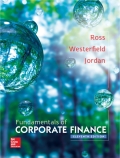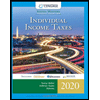
Fundamentals of Corporate Finance
11th Edition
ISBN: 9781259870576
Author: Ross
Publisher: MCG
expand_more
expand_more
format_list_bulleted
Concept explainers
Textbook Question
Chapter 15, Problem 2CRCT
Debt versus
Expert Solution & Answer
Want to see the full answer?
Check out a sample textbook solution
Students have asked these similar questions
I need help with financial accounting question
I am looking for help with financial accounting question
Please Make Sure The Answer is correct. Answer provide With Financial Accounting method
Chapter 15 Solutions
Fundamentals of Corporate Finance
Ch. 15.1 - Prob. 15.1ACQCh. 15.1 - Prob. 15.1BCQCh. 15.2 - What are the basic procedures in selling a new...Ch. 15.2 - What is a registration statement?Ch. 15.3 - Prob. 15.3ACQCh. 15.3 - Why is an initial public offering necessarily a...Ch. 15.4 - Prob. 15.4ACQCh. 15.4 - Prob. 15.4BCQCh. 15.5 - Prob. 15.5ACQCh. 15.5 - Suppose a stockbroker calls you up out of the blue...
Ch. 15.6 - What are some possible reasons why the price of...Ch. 15.6 - Explain why we might expect a firm with a positive...Ch. 15.7 - What are the different costs associated with...Ch. 15.7 - What lessons do we learn from studying issue...Ch. 15.8 - Prob. 15.8ACQCh. 15.8 - What questions must financial managers answer in a...Ch. 15.8 - Prob. 15.8CCQCh. 15.8 - When does a rights offering affect the value of a...Ch. 15.8 - Prob. 15.8ECQCh. 15.9 - What are the different kinds of dilution?Ch. 15.9 - Is dilution important?Ch. 15.10 - What is the difference between private and public...Ch. 15.10 - Prob. 15.10BCQCh. 15.11 - What is shelf registration?Ch. 15.11 - Prob. 15.11BCQCh. 15 - Prob. 15.1CTFCh. 15 - Smythe Enterprises is issuing securities under...Ch. 15 - Prob. 15.4CTFCh. 15 - Prob. 15.7CTFCh. 15 - Debt versus Equity Offering Size [LO2] In the...Ch. 15 - Debt versus Equity Flotation Costs [LO2] Why are...Ch. 15 - Bond Ratings and Flotation Costs [LO2] Why do...Ch. 15 - Underpricing in Debt Offerings [LO2] Why is...Ch. 15 - Prob. 5CRCTCh. 15 - Prob. 6CRCTCh. 15 - Prob. 7CRCTCh. 15 - Prob. 8CRCTCh. 15 - Prob. 9CRCTCh. 15 - Prob. 10CRCTCh. 15 - Prob. 1QPCh. 15 - Prob. 2QPCh. 15 - Rights [LO4] Red Shoe Co. has concluded that...Ch. 15 - Prob. 4QPCh. 15 - Calculating Flotation Costs [LO3] The Valhalla...Ch. 15 - Prob. 6QPCh. 15 - Prob. 7QPCh. 15 - Prob. 8QPCh. 15 - Dilution [LO3] Eaton, Inc., wishes to expand its...Ch. 15 - Prob. 10QPCh. 15 - Dilution [LO3] In the previous problem, what would...Ch. 15 - Prob. 12QPCh. 15 - Value of a Right [LO4] Show that the value of a...Ch. 15 - Prob. 14QPCh. 15 - Prob. 15QPCh. 15 - Prob. 1MCh. 15 - Prob. 2MCh. 15 - Prob. 3MCh. 15 - Prob. 4M
Knowledge Booster
Learn more about
Need a deep-dive on the concept behind this application? Look no further. Learn more about this topic, finance and related others by exploring similar questions and additional content below.Similar questions
- Explain how understanding the full cost of services important in public and nonprofit budgeting?arrow_forwardAgreee or disagree with post The temporary value of money (TVM) is an important concept in finance. TVM states that the money available now is worth more than the same amount in the future. This is because money can earn interest over time. A key assumption of this model is that money will obtain consistent performance. This assumption helps people make decisions about savings, investment and spending. For example, knowing that money grows can motivate people to save for future objectives. However, this model has limitations. The assumption of consistent yields may not be true in real life due to changes in the market or economic conditions. Therefore, although the temporal value of money is useful for planning, it is essential to consider the risks and uncertainties in financial decision making. Agree or disagree with postarrow_forwardWhat is the time value of money concept? Explain one of the assumptions behind the TVM model. How does this assumption limit the application of this model?arrow_forward
- agree or disagree with post TVM or time value of money is the suggestion that todays currency will be more profitable in the future. This concept comes from the action of investing, which produces returns and in short monopolizes the investment. One of the biggest assumptions behind the TVM model is that the economic conditions will remain steady enough to produce a profit for the consumer. This model does not account for inflation, fluctuation of the market, and even different government actions which can impact the economy. This limits the application of the model because it is not accurate and due it being based off of a growing interest rate only which we all know is not the case. Investing can be unpredictable and ever changing so that needs to be taken into account in models such as these. agree or disagree with postarrow_forwardHow are HRISs changing how companies manage their compensation and benefit plans?arrow_forward3. A bond's yield to maturity (YTM) is:A. The coupon rateB. The rate of return required by investorsC. The market price of the bondD. The par value of the bondarrow_forward
- Need help The time value of money concept suggests:A. A dollar today is worth less than a dollar tomorrowB. Money loses value over time due to inflationC. A dollar today is worth more than a dollar in the futureD. Interest has no effect on present valuearrow_forwardThe time value of money concept suggests:A. A dollar today is worth less than a dollar tomorrowB. Money loses value over time due to inflationC. A dollar today is worth more than a dollar in the futureD. Interest has no effect on present valuearrow_forward(Related to Checkpoint 17.1) (Forecasting discretionary financing needs) Huang Electronics, Inc., operates a chain of electrical lighting and fixture distribution centers throughout northern Arizona. The firm is anticipating expansion of its sales in the coming year as a result of recent population growth trends. The firm's financial analyst has prepared pro forma balance sheets that reflect three different rates of growth in firm sales for the coming year and the corresponding non-discretionary sources of financing the firm expects to have available, as follows: a. What are the firm's discretionary financing needs under each of the three growth scenarios? b. What potential sources of financing are there for Huang Electronics to fulfill its needs for discretionary financing? a. The discretionary financing needs for a 10% growth scenario are $ (Round to the nearest dollar.)arrow_forward
- (Related to Checkpoint 17.1) (Forecasting discretionary financing needs) In the spring of 2023, the Caswell Publishing Company established a custom publishing business for its business clients. These clients consisted principally of small- to medium-size companies in Round Rock, Texas. However, the company's plans were disrupted when it landed a large printing contract which it expects will run for several years. Specifically, the new contract will increase firm revenues by 100 percent. Consequently, Caswell's managers know they will need to make some significant changes in firm capacity, and quickly. The following balance sheet for 2023 and pro forma balance sheet for 2024 reflect the firm's estimates of the financial impact of the 100 percent revenue growth: a. How much new discretionary financing will Caswell require based on the above estimates? b. Given the nature of the new contract and the specific needs for financing that the firm expects, what recommendations might you offer…arrow_forward(Related to Checkpoint 17.1) (Forecasting discretionary financing needs) Bates Fabricators, Inc. estimates that it invests 25 cents in assets for each dollar of new sales. However, 4 cents in profits are produced by each dollar of additional sales, of which 1 cent(s) can be reinvested in the firm. If sales rise by $773,000 next year from their current level of $5.36 million, and the ratio of spontaneous liabilities to sales is 0.17, what will be the firm's need for discretionary financing? (Hint: In this situation, you do not know what the firm's existing level of assets is, nor do you know how those assets have been financed. Thus, you must estimate the change in financing needs and match this change with the expected changes in spontaneous liabilities, retained earnings, and other sources of discretionary financing.) The discretionary financing needs will be $ (Round to the nearest dollar.)arrow_forwardI mistakenly submitted blurr image please comment i will write values. please dont Solve with incorrect values otherwise unhelpful.need helparrow_forward
arrow_back_ios
SEE MORE QUESTIONS
arrow_forward_ios
Recommended textbooks for you
 EBK CONTEMPORARY FINANCIAL MANAGEMENTFinanceISBN:9781337514835Author:MOYERPublisher:CENGAGE LEARNING - CONSIGNMENT
EBK CONTEMPORARY FINANCIAL MANAGEMENTFinanceISBN:9781337514835Author:MOYERPublisher:CENGAGE LEARNING - CONSIGNMENT Intermediate Accounting: Reporting And AnalysisAccountingISBN:9781337788281Author:James M. Wahlen, Jefferson P. Jones, Donald PagachPublisher:Cengage Learning
Intermediate Accounting: Reporting And AnalysisAccountingISBN:9781337788281Author:James M. Wahlen, Jefferson P. Jones, Donald PagachPublisher:Cengage Learning College Accounting, Chapters 1-27AccountingISBN:9781337794756Author:HEINTZ, James A.Publisher:Cengage Learning,
College Accounting, Chapters 1-27AccountingISBN:9781337794756Author:HEINTZ, James A.Publisher:Cengage Learning, Individual Income TaxesAccountingISBN:9780357109731Author:HoffmanPublisher:CENGAGE LEARNING - CONSIGNMENT
Individual Income TaxesAccountingISBN:9780357109731Author:HoffmanPublisher:CENGAGE LEARNING - CONSIGNMENT

EBK CONTEMPORARY FINANCIAL MANAGEMENT
Finance
ISBN:9781337514835
Author:MOYER
Publisher:CENGAGE LEARNING - CONSIGNMENT

Intermediate Accounting: Reporting And Analysis
Accounting
ISBN:9781337788281
Author:James M. Wahlen, Jefferson P. Jones, Donald Pagach
Publisher:Cengage Learning

College Accounting, Chapters 1-27
Accounting
ISBN:9781337794756
Author:HEINTZ, James A.
Publisher:Cengage Learning,


Individual Income Taxes
Accounting
ISBN:9780357109731
Author:Hoffman
Publisher:CENGAGE LEARNING - CONSIGNMENT

What is WACC-Weighted average cost of capital; Author: Learn to invest;https://www.youtube.com/watch?v=0inqw9cCJnM;License: Standard YouTube License, CC-BY